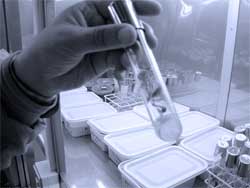Micro-propagation of
fibrous species
 Micro-propagation of
fibrous species
One of the central axes of the
research performed in the
Forestry Biotechnological
Laboratory (LBF) is the
strengthening of the multiplication
capacities of fibrous species
through vegetal strengthening
and renewal. Since 1999, this
Laboratory, which is part of the
Faculty of Forestry Sciences, has
investigated and tested several
micro-propagation techniques in
exotic and native trees that are
important in the lumber (radiata
pine, eucalyptus, poplar, oak,
among others); fruit (chestnut,
cherry, walnut and hazelnut);
and environmental (hazelnut,
pitao, keule) plantations. Micro-propagation of
fibrous species
One of the central axes of the
research performed in the
Forestry Biotechnological
Laboratory (LBF) is the
strengthening of the multiplication
capacities of fibrous species
through vegetal strengthening
and renewal. Since 1999, this
Laboratory, which is part of the
Faculty of Forestry Sciences, has
investigated and tested several
micro-propagation techniques in
exotic and native trees that are
important in the lumber (radiata
pine, eucalyptus, poplar, oak,
among others); fruit (chestnut,
cherry, walnut and hazelnut);
and environmental (hazelnut,
pitao, keule) plantations.
In most cases, the propagation
based on embryonic tissues
(seeds) or asexually (posts,
grafted, among others), has been
successfully achieved, assisting
in another scientific objective of
LBF: generate elite genotypes.
Organogenesis and
embryogenesis
Micro-propagation is part of
vegetal propagation and permits
plant multiplication based on
small portions of vegetal tissue.
Also know as in vitro cultivation,
it is associated directly with
organogenesis and somatic
embryogenesis.
The first one permits organic
formation from tissue particles
or from complete organs (leaves,
stems, yolks). The second one
is oriented to the obtainment,
from somatic (asexual) tissues,
similar structures to the ones that
originated sexual fecundation and
the subsequent seed formation.
These structures, called somatic
embryos, have the same form
and functioning of a sexually
originated natural embryonic axis,
although it does not have
endosperm or reserve material.
LBF has performed basic research
on both processes. Their
emphasis has been in the somatic
embryogenesis of fibrous trees
because it offers more options of
tissue manipulation. The somatic
methodologies for oak and raulí
(with which the greatest advances
have been made) have already
been established, and researchers
are at the point of achieving it
with eucalyptus (globulus and
nitens) and chestnut, in which
the maturation and germination
phases of the produced embryos
as well as their encapsulation to
generate artificial seeds are still
in process
Mature seed versus
immature seed
In vitro cultivation, sexually, it is
important to note the tissue’s
development stage at the
moment of collection. The best
results are achieved with
immature seeds, although they
have the disadvantage of a time
limit for collection from the
mother trees and germoplasm
manipulation when there is no
adequate storage. As an
alternative, LBF has experimented
with adult seeds, standardizing
the multiplication protocols for
eucalyptus (globulus and nitens),
radiata pine, araucaria, roble,
raulí, coigüe, hazelnut, walnut,
chestnut, cherry, pitao, poplar,
whose plants have been tested
in the field.
The adult path
Despite the advantages
associated with sexually produced
seeds, LBF has established a line
of work with somatic tissue. In
this case, the age of the mother
plant plays a fundamental role.
The majority of the research has
been with young plants.
However, the Laboratory
developed the program with
tissues collected in adult plants,
where the selection of the
genotypes is simpler because all
their characteristics can be seen.
In this area, successful results
have been achieved in fruit
species such as chestnut and
walnut as well as in the lumber
species of radiata pine and
eucalyptus globlus. These results
are being confirmed in
greenhouses and plantations.
This year, we hope to establish
the first plantation of chestnuts
selected and multiplied using this
technique in addition to plots of
the Chilean hazelnut for its wood
and fruit production.
Youth inductors
Searching for the greatest
applicability of selected genotype
multiplication, LBF is researching
the improvement of adult
material through the use of youth
inductors. The Laboratory has
finished the bio-chemical and
physiological studies on the
relation between adult and
juvenile tissues as well as the
management of the reciprocal
effects at a metabolic level.
The idea is to transmit the
juvenile metabolism to the old
tissues so that they reproduce
and grow at a greater velocity.
The process consists in submitting
the chosen tree’s sleeping yolks
to a climatic stimulation process
(performed in the Laboratory) to
be later planted, cultivated in
vitro or destined to proliferate
chains that reproduce the genetic
material from portions of leaves,
stems, or roots. The technique
has been applied in the
propagation of chestnut and could
be extended to other species. |

